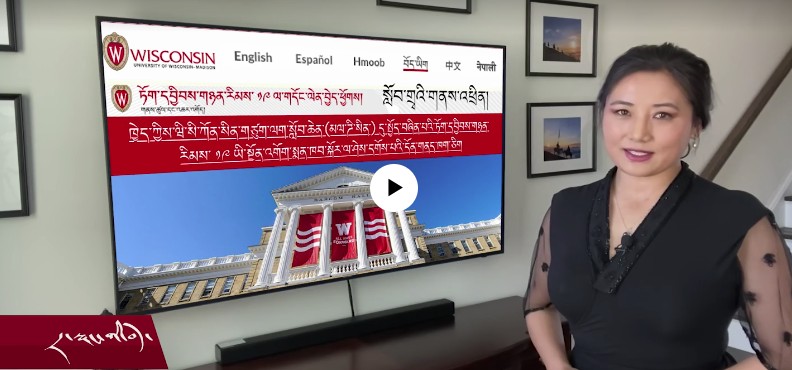COVID-19 multilingual site recognized

Recently, UW–Madison’s COVID-19 multilingual site was highlighted by Voice of America’s Tibetan news as a great example of how linguistic diversity and inclusion are recognized and honored by the university. Voice of America
ཏོག་དབྱིབས་གཉན་རིམས་ ༡༩.
For the more than six million people who speak Tibetan, including more than 100 UW–Madison employees, that means COVID-19.
Communication is always important but during a pandemic, it’s been absolutely crucial. Recently, UW–Madison’s COVID-19 multilingual site was highlighted by Voice of America’s Tibetan news as a great example of how linguistic diversity and inclusion are recognized and honored by the university.
“Some people approached me by phone and in person and acknowledged and thanked me for UW–Madison’s honor and inclusion of Tibetan language,” says Yangbum Gyal, a Tibetan interpreter, translator and trainer with Cultural Linguistic Services who was included in the Voice of America video.

Yangbum Gyal, a Tibetan Interpreter, Translator & Trainer with Cultural Linguistic Services, speaks with Voice of America’s Tibetan news about the work UW–Madison is doing to make sure people have essential COVID-19 information. He also spoke about the university’s dedication to multilingual communication by translating documents such as job applications and campus information as well as offering on-site interpretation of safety training and benefits meetings.
Safety tips, questions about testing, updates on vaccine availability — all are important information that people need to have access to and understand, no matter what language they speak.
Besides English and Tibetan, UW–Madison’s COVID-19 Response website also offers translations in Spanish, Hmong, Chinese and Nepali, thanks to Cultural Linguistic Services.
The international multimedia broadcaster based in Washington, D.C., chose to recognize UW–Madison on Feb. 21, celebrated by the United Nations as International Mother Language Day, a day to recognize that languages and multilingualism can advance inclusion. This year’s observance called upon policymakers, educators and families to scale up their commitment to multilingual education, and inclusion in education to advance recovery in the context of COVID-19.
Multilingual communication has been a priority throughout the past year for UW–Madison, says CLS director Carmen Romero González, and has been a joint effort across several offices on campus, including University Communications, University Marketing, the Office of Human Resources and Vice Chancellor for Finance and Administration Laurent Heller.
“The pandemic has impacted the daily interactions with employees and with our campus community, so multilingual communication has become more significant than ever before,” Romero González says. “We are also supporting the multilingual communication with WhatsApp groups in the six languages CLS provides. Employees can sign up for these groups and receive important campus information directly on their phones.”
CLS collaborates closely with departments where English language learner employees work. These departments have integrated language services, including having meetings and communication interpreted and multilingual town halls. Employees feel much more comfortable and included when they can ask questions in their preferred language, especially about topics that impact their work and life, Romero González says.
“Language and culture are essential aspects of diversity,” Romero González says. “Many employees rely on multilingual communication to be informed about campus guidelines, and to access resources and opportunities, particularly during critical times.”
Translation of documents such as job applications, policy statements and presentations is also offered by CLS as well as on-site interpretation for group events, meetings between supervisors and employees, benefits meetings and safety trainings.
“It is important because this helps people acclimate to the prevailing workplace culture and enhance understanding the differences,” Gyal says. “Additionally, it helps to foster an inclusive and diverse work environment and community.”
In that spirit, Gyal offers a bit of information about the Tibetan language. The Tibetan language belongs to the Tibet-Burman family of languages. Tibetan has various dialects and is spoken over an area the size of western Europe. Tibetan syntax is very different from that of European languages, he says. The word order follows “subject-object-verb.”
Gyal is thankful the university supports and honors the linguistic diversity on campus and is grateful to play a role in fostering inclusiveness.
“I’m especially inspired serving as a bridge between language and cultural gaps as well when I’m able to support employees’ and community members’ welfare and happiness by assisting with their work-related issues and communication problems,” Gyal says. “I hope to continue promoting respect and diversity in the campus multilingual and multi-shift workplace — and hope that my small contribution of work adds tiny drops of water into the fulfillment of the university’s immense ocean of mission and vision.”



